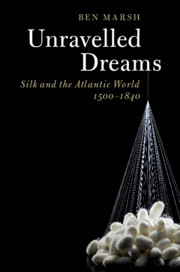Book contents
- Unravelled Dreams
- Unravelled Dreams
- Copyright page
- Dedication
- Contents
- Colour Plates
- Figures
- Maps
- Tables
- Acknowledgements
- 1 Prologue
- Part I Emergence
- 2 Spain and New Spain
- 3 England and Virginia
- 4 France and New France
- Part II Persistence
- Part III Convergence
- Select Bibliography
- Index
- Plate Section (PDF Only)
4 - France and New France
from Part I - Emergence
Published online by Cambridge University Press: 08 October 2020
- Unravelled Dreams
- Unravelled Dreams
- Copyright page
- Dedication
- Contents
- Colour Plates
- Figures
- Maps
- Tables
- Acknowledgements
- 1 Prologue
- Part I Emergence
- 2 Spain and New Spain
- 3 England and Virginia
- 4 France and New France
- Part II Persistence
- Part III Convergence
- Select Bibliography
- Index
- Plate Section (PDF Only)
Summary
France’s introduction of mulberries and silkworms originated in the pincer-like arrival of resources and expertise across both its Spanish and Italian borders, and production would last through to the end of the nineteenth century, concentrated in southern regions. This chapter considers the moments of acceleration in the seventeenth century when French schemes (pushed by agronomists and political economists) sought to carry production to new regions. The fact that French domestic production of raw silk never came close to the quantity or quality required by its silk industry encouraged new ambitions overseas. The chapter tracks in turn the idiosyncratic projects in the French Caribbean in the late seventeenth century, and the more concerted ambitions and undertakings in Louisiana in the early eighteenth century – in both of which cases, enslaved labourers were mobilised for a time to nurture silkworms and reel silk, and women played prominent roles. French efforts around the Caribbean basin were compromised by competition with other crops, by the instability of the region’s geopolitics, and by a host of commodity-specific threats which showed up the fragility of silkworms. Even while French New World prospects of sericulture retreated, however, production was consolidated and deepened at home, thanks to environmental and labour advantages.
- Type
- Chapter
- Information
- Unravelled DreamsSilk and the Atlantic World, 1500–1840, pp. 162 - 208Publisher: Cambridge University PressPrint publication year: 2020

